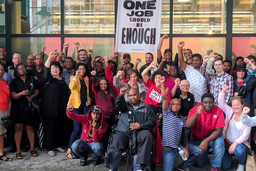UE Organizing Director Bob Kingsley Prepares To Step Down, But Lefty Union Shows No Signs of Slowing
Bruce Vail

In an emotional moment last week, Bob Kingsley received a long, loud and sometimes raucous standing ovation from about 250 hardcore union men and women meeting in a Baltimore hotel.
The ovation was less a response to the report he had just delivered to the convention delegates of the United Electrical, Radio, and Machine Workers of America (UE) than to the fact that his remarks were a sort of swan song, representing Kingsley’s last official report after serving 22 years as the union’s Director of Organization. Kingsley will retire from UE in several months, and the ovation was a personal tribute to his many years in the front lines of labor organizing.
But there was little to reflect a retiring spirit in Kingsley’s report. He spoke boldly of the union’s recent successes in organizing California van drivers at Renzenberger, a Kansas-based company that specializes in providing low-cost contract labor to railroads. He also spoke passionately of organizing efforts at General Electric plants in Texas and elsewhere, where the union is engaged in long-running campaigns to increase its membership in the company’s sprawling network of U.S. factories. And new initiatives are sprouting, with organizers from UE’s Young Activist Program visiting several new sites in Baltimore last week, including an Amazon warehouse that just opened early this year.
Kingsley estimates that organizing campaigns have brought 30,000 members into the union during his tenure as director, roughly equal to UE’s current membership. The union continues to lose membership in its historic base in the manufacturing sector, he says, but is growing in the transportation and public employees sectors. It’s a victory of a kind that UE has not been shrinking over the last decade, he adds, as have most other manufacturing unions. (At 30,000 members, UE is a shadow of its former self, having peaked at about 500,000 in 1945.)
Much attention in the last four years has been on the Renzenberger campaign. The high point thus far was a solid win early this year in a union recognition election for about 600 van drivers in California. UE organizers have been active in California railyards for nearly four years, he says, and UE was forced to battle for representation rights with National Production Workers Union Local 707. Local 707 had been foisted on the pro-UE workers by Renzenberger managers, Kingsley tells In These Times, as part of a plan to keep the more militant UE out. That plan failed, but UE had to devote substantial resources to defeating both Local 707 and Renzenberger managers.
“We’ve been working for over five years” to get UE representation, says Malissa Gollaher, one of the California divers who traveled to Baltimore for the convention. Some 17 pro-union workers were improperly fired during the battle between the two unions, she claims, but “we won 17 people their jobs back, with pay. I know, I was one of them.”
UE has ambitions to represent other Renzenberger employees in other states and has already formed smaller units in Ohio, Illinois and Nevada. The largest of these units — about 100 workers — is in Chicago, where the union won a very close National Labor Relations Board election this year, only to see legal certification delayed by legal challenges to the vote.
Renzenberger may ultimately become the largest single employer of UE members, Kingsley speculates, a distinction now held by General Electric. Most of the 3,400 members toil at GE’s locomotive shops in Erie, Pennsylvania, but these jobs are under threat as GE moves to shift work to a new non-union locomotive facility in Fort Worth, Texas. UE organizers visited the Fort Worth site this year, Kingsley reports, in an effort to build union support. It’s too early to talk about an election at Fort Worth, he tells In These Times, but it is one of several of 17 non-union GE workplaces that are in the organizers’ sights.
GE has been very problematic for UE over the years, Kingsley continues, providing a significant number of good jobs, but also aggressively outsourcing its operations overseas or to right-to-work states. Most recently, GE moved to close its capacitor plant in Fort Edward, New York, eliminating about 175 UE jobs. The manufacturing work currently done by union workers in New York will be taken over by non-union workers in Clearwater, Florida, next year.
There is no reason to expect any radical changes in the way the union’s organizing department operates next year, says UE’s Gene Elk, who was elected last week to succeed Kingsley.
“The real and enduring qualities of UE are rank-and-file control and aggressive struggle with employers. I intend to broaden [the union’s efforts] in both of these things,” Elk tells In These Times. “One of things that I am committed to doing as an elected officer is listening to the members, so that is the first thing on my agenda” as the new Director of Organization, Elk says.
Listening to the members means that he brings no grandiose new strategy to his position, Elk continues. Programs established in the past, such as the Chicago-based labor center Warehouse Workers for Justice were intended to be long-term projects and there is no intention of changing that now, he says.
It’s the warehouse project that brought organizers to the Amazon site in Baltimore last week, Elk explains. UE is not targeting a national Amazon campaign, but it does want to test the waters at select locations. Organizers were encouraged by what they learned, he says, with many Amazon workers interested in the benefits of unionization. “Of course, they [Amazon] called the cops on us,” he laughs.
For Kingsley, he says he plans to continue to be active in the labor movement after his retirement, with UE or perhaps with other unions. “I’m not really ready to hang it up yet entirely. We’ll see what happens,” he says.







